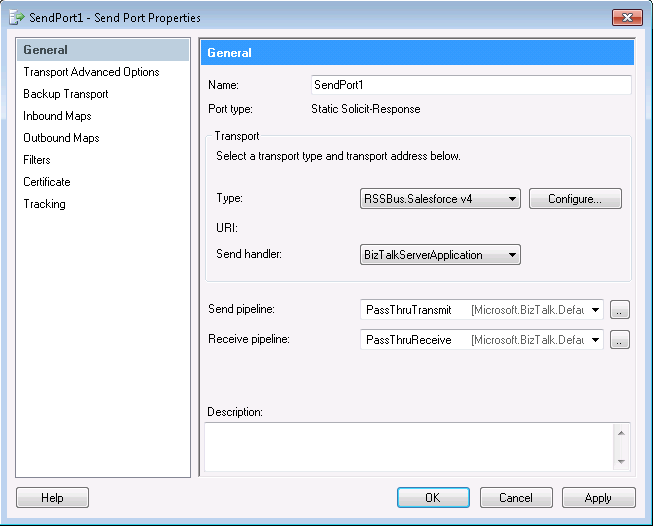Discover how a bimodal integration strategy can address the major data management challenges facing your organization today.
Get the Report →Configure a Solicit-Response Send Port for the CData BizTalk Adapter for MYOB AccountRight
Use the adapter for MYOB AccountRight with a solicit-response send port to execute updategrams and data manipulation SQL in BizTalk.
This section provides step-by-step instructions for creating, configuring, and testing a static solicit-response send port using the CData BizTalk Adapter for MYOB AccountRight. You can use a static solicit-response send port to execute commands and access the results in BizTalk. You can use send ports to execute updategram commands, SQL commands, and stored procedure operations.
Create and Configure the Send Port
Create a static solicit-response send port and configure it to use the adapter as its transport type.
- If you have not already done so, open your BizTalk application in the BizTalk Administration Console.
- In the node for your BizTalk application, right-click Send Ports and select New -> Static Solicit-Response Send Port. The Send Port Properties dialog is displayed.
- In the Send Port properties, enter a name for the receive port.
- In the Transport Type menu, select CData.MYOB;.
- In the Send pipeline menu, select the default option, PassThruTransmit.
- In the Receive pipeline menu, select the default option, PassThruReceive.

Configure the Adapter
Define the command the adapter will execute in the Transport Properties dialog.
- In the send port properties, click the Configure button. The Adapter Transport Properties dialog is displayed.
- In the CommandType property, select the command type you want.
- If you want to execute an SQL command, enter the command in the SQL Command box.

Configure the Connection to MYOB AccountRight
Configure credentials and other properties required to connect to MYOB AccountRight in the Connection String Options dialog.
- In the send port properties, click Configure. The adapter properties dialog is displayed.
- Click the button in the Connection String property. The Connection String Options dialog is displayed.
- Enter the connection properties. Below is a typical connection string:
OAuthClientId=YourClientId; OAuthClientSecret=YourClientSecret; CompanyFileId=yourCompanyFileId; CallbackURL=http://localhost:33333; User=companyFileUser; Password=companyFilePassword; InitiateOAuth=GETANDREFRESHThese properties are required when connecting to a company file (both for Cloud and On-Premise instances).
- CompanyFileId: You can find this by starting MYOB, opening your data file, and selecting Help -> About MYOB
- User: The username associated with your company file.
- Password: The password associated with your company file.
Connecting to a Cloud Instance
To connect to a cloud instance of MYOB, you can use the embedded OAuth credentials or create an OAuth app with MYOB. This process is detailed in the Help documentation.
Connecting to an On-Premise instance:
When connecting to an on-premise instance, you will need to set the following connection property in addition to those above:
- InitiateOauth: Set this to OFF.
- Url: The Url of your MYOB instance.
- Click Test Connection to verify the values and test connectivity.
 The updategram tutorial for the adapter for MYOB AccountRight walks through the steps to create a simple application that uses a solicit-response send port to execute an insert updategram to MYOB AccountRight.
The updategram tutorial for the adapter for MYOB AccountRight walks through the steps to create a simple application that uses a solicit-response send port to execute an insert updategram to MYOB AccountRight.






